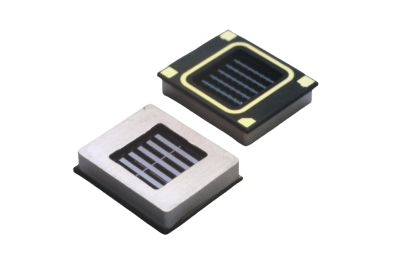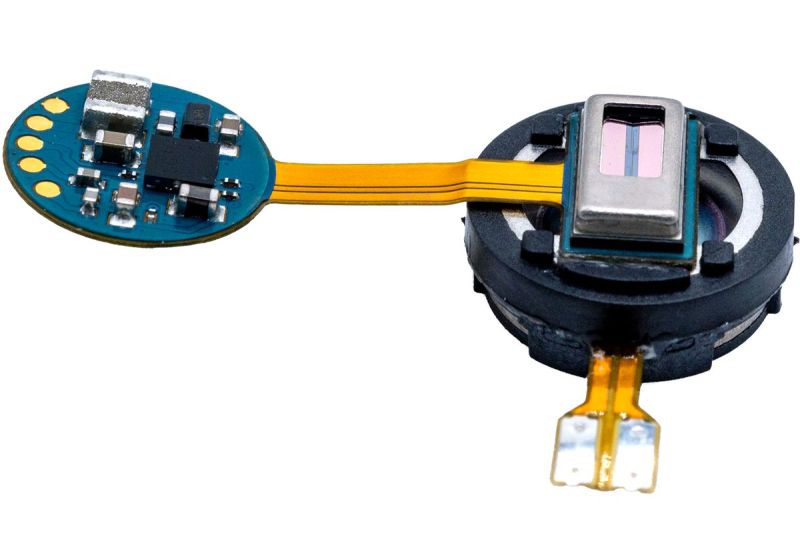These days it’s hard to not come across solid-state (micro-electromechanical systems, MEMS) microphones, as they are now displacing electret microphones almost everywhere due to their small size and low cost. Although MEMS speakers are not impossible, creating a miniature speaker that can both displace a lot of air (‘volume’) and accurately reproduce a wide range of frequencies – unlike simple piezo buzzers – is a lot tougher. Here a startup called xMEMS figures that they have at least partially cracked the code with their piezoMEMS speakers, with Creative using the Cowell version in their brand-new Aurvana Ace in-ear monitors.

The Cowell is a full-range speaker, but its sound pressure level (SPL) is not sufficient (~111 dB @ 1 kHz) for use in an active-noise cancelling, which is why the Aurvana Ace also includes a traditional 10 mm driver. The likely successor in the form of Cypress is a small (6.5 x 6.3 x 1.65 mm) package that claims to reach an SPL of 143 dB at 20 Hz, which might be able to handle IEM ANC duty by itself.
According to xMEMS, what enabled the performance of these MEMS speakers is the use of silicon membranes (flaps) along with the piezo elements. These structures can be made out with some degree of clarity on the speakers, and according to early hands-on tests of the Aurvana Ace, audio quality is very good. Since with this first product the MEMS speaker mostly handles the high-end, the overall audio reproduction is a combination of the dynamic driver, the MEMS speaker and the DSP magic that glues it all together, so it’s hardly a fair assessment of the technology, but it will be interesting to see where it goes from here. Who doesn’t want to have a feather-light, 1×1 meter PCB that’s a wafer-thin 1 500 Watt RMS-level speaker, or just laptop speakers that don’t sound terrible?
Top image: XMems Cowell MEMS-based tweeter on top of dynamic driver. (Credit: xMEMS)
















Would these be useful in a phase array where you need a larger sound field but one that is directional? e.g. Your device can see you with its camera so it knows where your ears are and can then project sound in stereo at them while you are looking at the screen as you would in a video call or while watching entertainment.
I assume this wafer-thin 1x1m speaker would also be a phased array, right?
I’d like to have some of these in the bezel of my tv instead of those two tiny speakers pointing downwards.
A tiny speaker attached to ATTiny10 and a small battery makes for great disposable annoying thing. Code it to sleep on power on for a few hours, then make noise and sleep for random x minutes. Repeat until the victim finds the device and destroys it.
Or hide it behind a power outlet ^^.
Or hide THEM behind several power outlets. Muhahahaha.
Reminds me of my last job. One of my buddies put an arduino inline with the control buttons for my other buddy’s sit-stand desk. I think it was one of the BLE ones, he had a little web interface where he could control the desk remotely. Eventually everyone (about 20 people) but the guy whose desk it was was in on the joke. It lasted about three years, through the maker leaving (he handed it off to another coworker), as it was only moved probably once a week on average, just enough to be really irritating but not enough to incite too deep of inspection. I was lucky enough to see the reveal just before I left, the guy was absolutely gobsmacked that we’d all managed to keep it from him for 3 years.
I would love to read proper Hackaday article about this.
grr what sadism!
i once tracked one of these down to whenever my x10 (computer-controlled AC electric switches) would send a command, if my keyboard cable happened to be draped across my pc speaker cable, then i’d get a beep. but there’s another more recent one that came and went and came and went a couple times and i still haven’t got an idea about it. what a nightmare
You can buy those things under the name annoyatron
I did this, with a coin cell battery and a magnet. Put it in my boss’s office set to beep once every minute or so, irregularly.
He looked for it for about 10 seconds once he realized something was up, and then came knocking straight on my door, smiling. Turns out you don’t need to find the device if you know the usual suspects well enough…
So I turned it into a present. He put it in his son’s room to “amuse” him.
uSound does this aswell
MEMS aren’t solid state.
They have moving parts.
Words have meaning and context is important.
If ‘solid state’ is a meaningful descriptor of something, then it matters whether or not the thing has those properties.
1) if you want to place yourself as arbiter of what words mean then go and write a dictionary. Solid state does not necessarily mean ‘no moving parts’. A MEMS device which functions as a monolithic block of solid matter can certainly be argued to be solid state. The definition isn’t as rigid as you seem to believe. There term emerged to describe electronic devices made in silicon which were previously assembled as valves or other electromechanical devices. They’ll didn’t envisaged MEMS when it was coined.
2) ‘solid state’ is widely accepted shorthand for it not having wear-limited moving parts or anything that needs lubrication like bearings, motors, etc. Equally obviously is that all MEMS devices have moving parts and are mechanical in nature, but if it comes in a non-serviceable PCB mount package that never needs servicing it doesn’t really matter, does it?
I mean, a “solid state drive” it also ‘technically’ a ‘moving part’ of I use it to hit pedant over the head.
Is nobody else wondering how it’s possible to output 20Hz at 145 dB out of a 6.5×6.5×1.65 mm driver? I cry foul…
My Black Shark 5 phone has a pair of stereo speakers that make laptops sound utterly garbage – how small/low maintenence do speakers need to get?